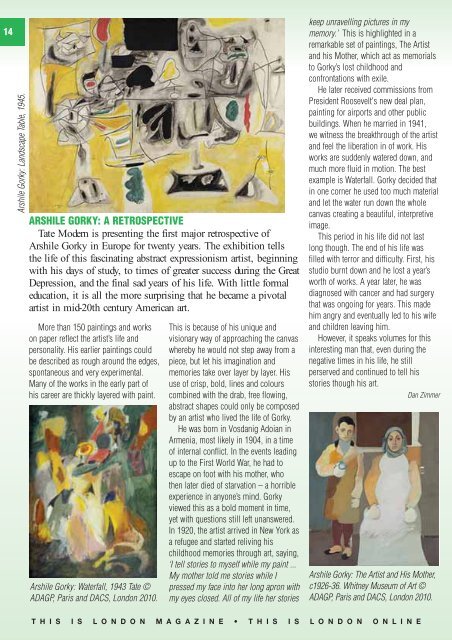A show of paintings by John Speirs, Oleg Tyrkin and Auguste Rodin ...
A show of paintings by John Speirs, Oleg Tyrkin and Auguste Rodin ...
A show of paintings by John Speirs, Oleg Tyrkin and Auguste Rodin ...
Create successful ePaper yourself
Turn your PDF publications into a flip-book with our unique Google optimized e-Paper software.
14<br />
Arshile Gorky: L<strong>and</strong>scape Table, 1945.<br />
ARSHILE GORKY: A RETROSPECTIVE<br />
Tate Modern is presenting the first major retrospective <strong>of</strong><br />
Arshile Gorky in Europe for twenty years. The exhibition tells<br />
the life <strong>of</strong> this fascinating abstract expressionism artist, beginning<br />
with his days <strong>of</strong> study, to times <strong>of</strong> greater success during the Great<br />
Depression, <strong>and</strong> the final sad years <strong>of</strong> his life. With little formal<br />
education, it is all the more surprising that he became a pivotal<br />
artist in mid-20th century American art.<br />
More than 150 <strong>paintings</strong> <strong>and</strong> works<br />
on paper reflect the artist’s life <strong>and</strong><br />
personality. His earlier <strong>paintings</strong> could<br />
be described as rough around the edges,<br />
spontaneous <strong>and</strong> very experimental.<br />
Many <strong>of</strong> the works in the early part <strong>of</strong><br />
his career are thickly layered with paint.<br />
Arshile Gorky: Waterfall, 1943 Tate ©<br />
ADAGP, Paris <strong>and</strong> DACS, London 2010.<br />
This is because <strong>of</strong> his unique <strong>and</strong><br />
visionary way <strong>of</strong> approaching the canvas<br />
where<strong>by</strong> he would not step away from a<br />
piece, but let his imagination <strong>and</strong><br />
memories take over layer <strong>by</strong> layer. His<br />
use <strong>of</strong> crisp, bold, lines <strong>and</strong> colours<br />
combined with the drab, free flowing,<br />
abstract shapes could only be composed<br />
<strong>by</strong> an artist who lived the life <strong>of</strong> Gorky.<br />
He was born in Vosdanig Adoian in<br />
Armenia, most likely in 1904, in a time<br />
<strong>of</strong> internal conflict. In the events leading<br />
up to the First World War, he had to<br />
escape on foot with his mother, who<br />
then later died <strong>of</strong> starvation – a horrible<br />
experience in anyone’s mind. Gorky<br />
viewed this as a bold moment in time,<br />
yet with questions still left unanswered.<br />
In 1920, the artist arrived in New York as<br />
a refugee <strong>and</strong> started reliving his<br />
childhood memories through art, saying,<br />
‘I tell stories to myself while my paint ...<br />
My mother told me stories while I<br />
pressed my face into her long apron with<br />
my eyes closed. All <strong>of</strong> my life her stories<br />
keep unravelling pictures in my<br />
memory.’ This is highlighted in a<br />
remarkable set <strong>of</strong> <strong>paintings</strong>, The Artist<br />
<strong>and</strong> his Mother, which act as memorials<br />
to Gorky’s lost childhood <strong>and</strong><br />
confrontations with exile.<br />
He later received commissions from<br />
President Roosevelt's new deal plan,<br />
painting for airports <strong>and</strong> other public<br />
buildings. When he married in 1941,<br />
we witness the breakthrough <strong>of</strong> the artist<br />
<strong>and</strong> feel the liberation in <strong>of</strong> work. His<br />
works are suddenly watered down, <strong>and</strong><br />
much more fluid in motion. The best<br />
example is Waterfall. Gorky decided that<br />
in one corner he used too much material<br />
<strong>and</strong> let the water run down the whole<br />
canvas creating a beautiful, interpretive<br />
image.<br />
This period in his life did not last<br />
long though. The end <strong>of</strong> his life was<br />
filled with terror <strong>and</strong> difficulty. First, his<br />
studio burnt down <strong>and</strong> he lost a year’s<br />
worth <strong>of</strong> works. A year later, he was<br />
diagnosed with cancer <strong>and</strong> had surgery<br />
that was ongoing for years. This made<br />
him angry <strong>and</strong> eventually led to his wife<br />
<strong>and</strong> children leaving him.<br />
However, it speaks volumes for this<br />
interesting man that, even during the<br />
negative times in his life, he still<br />
perserved <strong>and</strong> continued to tell his<br />
stories though his art.<br />
Dan Zimmer<br />
Arshile Gorky: The Artist <strong>and</strong> His Mother,<br />
c1926-36. Whitney Museum <strong>of</strong> Art ©<br />
ADAGP, Paris <strong>and</strong> DACS, London 2010.<br />
T H I S I S L O N D O N M A G A Z I N E • T H I S I S L O N D O N O N L I N E


